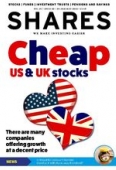Archived article
Please note that tax, investment, pension and ISA rules can change and the information and any views contained in this article may now be inaccurate.
Discover the FTSE 350 growth stocks trading at a discount to the market

Although many developed markets have hit a new all-time high in recent months, the FTSE 350 index of UK stocks still trades below the highs achieved in the middle of 2018.
There are plenty of cheap shares on offer in this index. In this article we uncover stocks expected to consistently grow earnings over the next two years that trade at a price to earnings multiple below the market. This investment strategy is sometimes called GARP or growth at a reasonable price.
Shares has used Stockopedia’s platform to screen for companies which are forecast to grow at least 5% a year over each of the next two years and which trade on a one-year forward PE ratio of less than 16 times, which is below where the index trades according to Refinitiv and Stockopedia data.
Screening is not intended to be an exact science, but it does allow us to reduce the FTSE 350 universe down to the most promising GARP candidates.
PROBING THE DATA
Not all companies have the same financial year end which means the damaging effect of the pandemic was reported through the accounts at different times.
This has in some instances resulted in the fiscal year one earnings growth estimate being distorted as analysts forecast a robust recovery following the reopening of the economy.
We have calculated an average growth rate for each company over both forecast years to smooth the return, but the distortion is still evident.
A good example is international private healthcare provider Mediclinic International (MDC) which runs hospitals in Switzerland, South Africa and the Middle East and was heavily impacted by lockdowns. Earnings are expected to grow eight-fold in the year to 31 March 2022 to 21p per share, as activity bounces back.
A better perspective in this case is to look at pre-pandemic earnings as the base. In March 2020 the company reported earnings of 27p per share and analysts expect the company to regain that level of earnings in the year to 31 March 2023.
In choosing our preferred stocks from the screen we have tried to look through the recovery in earnings and focused on companies which are expected to achieve consistent growth post-pandemic.
STRUCTURALLY LOWER PE RATIOS
When searching for companies trading below the market PE, please note that some sectors have historically always traded at a discount, so we need to take this into account when assessing the candidates that qualify for the screen.
In other words, just because a share trades on a low PE multiple doesn’t automatically make it an attractive investment proposition.
Lower PEs can sometimes reflect higher risk or lack of earnings visibility. Retail banks are a good example with the sector regularly trading at a discount to the market.
The main reason is that banks have leverage built into their balance sheets which makes them riskier while the prospect of loan impairments from bad debts lowers earnings visibility. No banks made it onto our stock screen because they failed the 5% earnings growth threshold in year two.
Sectors which have volatile earnings and are sensitive to the economic cycle also tend to trade at lower than market valuations to reflect the higher uncertainty in earnings. The mining sector fits this category and historically it has traded at a discount to the market.
For similar reasons to the banks, the miners failed to qualify because of a lack of expected future earnings growth that matches our requirement.
Four housebuilders made the list of candidates including Taylor Wimpey (TW.), Vistry (VTY), Bellway (BWY) and Crest Nicholson (CRST).
Earnings of investment banks and wealth managers tend to reflect a leveraged bet on the movement of stock markets, given their fee structures and high fixed costs which can leave them vulnerable in bear markets. This risk has historically been reflected in lower PEs.
Investment bank Investec (INVP) and wealth managers Brewin Dolphin Holdings (BRW), Schroders (SDR) and Rathbones (RAT) all made the list of candidates on our screen.
TOP PICKS FROM OUR FTSE 350 CHEAP STOCKS SCREEN
Next (NXT) £76.50
Clothing retailer Next enjoyed strong Christmas trading and upgraded full year profit expectations while also declaring a special dividend to be paid at the end of January.
However, the company noted some headwinds for the current year including increased pressure on household disposable incomes from rising inflation.
The company flagged the risk that the boost from pent-up demand and savings fades and a return to spending on overseas holidays and other social activities could depress demand for clothing and homewares.
Despite these near-term concerns, we believe the company is well positioned to face the challenges and prosper in the medium term as it adapts to a changing consumer landscape.
Over the past decade, Next has successfully transitioned from a store-led business model to an online-led one, with physical stores expected to represent less than 30% of the estate in the current year.
At the same time the company has built its own online business to provide a third-party e-commerce outsourcing service named Total Platform, which launched in May 2020 after a pilot exercise.
We believe Total Platform has potential to contribute meaningful revenues and profits over time and it leverages the company’s infrastructure, warehousing and logistics expertise.
Vodafone (VOD) 117.3p
Vodafone has been a laggard for many years, but some analysts think the company has turned a corner as it focuses more on growth, eking out operational efficiencies and cutting back on capital expenditures.
In November the company upgraded its earnings expectations for the financial year ending 31 March 2022, to the upper end of guidance. That implied underlying profits growth of between 4.5% to 5.9% to between €15.2 billion and €15.4 billion.
Adjusted free cash flow is also expected to be marginally better than previous forecasts at around €5.3 billion, underpinning the dividend.
It is noteworthy that analysts have increased their 2022 earnings estimates by around 5% since the half year report in November, while 2023 earnings are expected to register solid double-digit growth.
In addition to accelerating earnings, the company has a prospective dividend yield of 6.5%. Meanwhile, the emergence of private equity looking for cheap assets in the telecom sector adds a further attractive dimension to the narrative.
GlaxoSmithKline (GSK) £17.05
Pharmaceutical company GlaxoSmithKline has two activist investors on its share register pushing for change and a sharper commercial focus with the aim of generating better returns.
Since the middle of last year, the company has seen a steady increase in upward earnings revisions from analysts indicating the company is starting to deliver on its strategy with increased earnings momentum.
Analysts expect close to double-digit earnings growth over both of the next two years, while management recently upgraded full year 2021 earnings guidance following a stronger than expected third quarter.
A catalyst which could potentially release further value is expected by the middle of the year when the consumer healthcare division, a joint venture with US healthcare company Pfizer, is demerged.
Unilever (ULVR) has already made a takeover bid for this business division and we expect other trade or private equity companies to also be interested.
Important information:
These articles are provided by Shares magazine which is published by AJ Bell Media, a part of AJ Bell. Shares is not written by AJ Bell.
Shares is provided for your general information and use and is not a personal recommendation to invest. It is not intended to be relied upon by you in making or not making any investment decisions. The investments referred to in these articles will not be suitable for all investors. If in doubt please seek appropriate independent financial advice.
Investors acting on the information in these articles do so at their own risk and AJ Bell Media and its staff do not accept liability for losses suffered by investors as a result of their investment decisions.
Issue contents
Danni Hewson
Editor's View
Feature
Great Ideas
News
- THG’s shares take another hit on growth and margin setback
- Why China has bucked a global trend by cutting rates
- Oil hitting $100 could take the FTSE 100 to new record highs
- The trusts trading well below their 10-year average valuation
- Unilever’s food arm could be sold amid shift in strategy
- Wage inflation could hurt many shares
- Billions wiped off the value of construction stocks

 magazine
magazine








